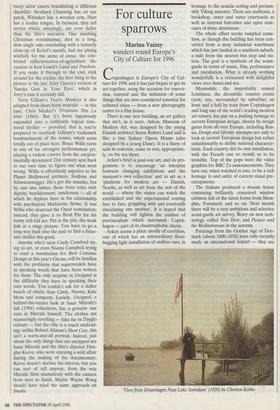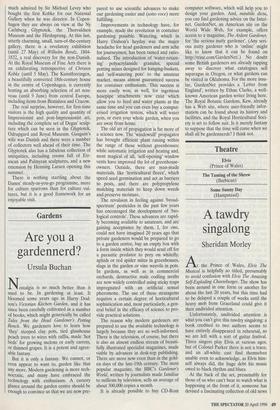For culture sparrows
Marina Vaizey wanders round Europe's City of Culture for 1996
Copenhagen is Europe's City of Cul- ture for 1996 and it has just begun to get its act together, using the occasion for renova- tion, renewal and the initiation of some things that are now considered essential for cultured cities — from a new photography centre to a film house.
There is one new building, an art gallery that isn't, as it were. Arken, Museum of Modern Art, was designed by the young Danish architect Soren Robert Lund arid" is like a tiny Sydney Opera House (also designed by a young Dane). It is a flurry of sails in concrete, come to rest, appropriate- ly, on the sea shore.
Arken's brief is post-war art, and its pro- gramme is to encourage 'an interplay between changing exhibitions and the museum's own collection' and to act as a `platform for modern art — Danish, Nordic, as well as art from the rest of the world — where the visitor can watch the established and the experimental coming face to face, grappling with and eventually elucidating one another'. It is hoped that the building will lighten the nimbus of provincialism which surrounds Copen- hagen — part of its claustrophobic charm.
Arken seems a place mostly of corridors, one of which has an extraordinary floor- hugging light installation of endless oars, in homage to the seaside setting and presum- ably Viking ancestry. There are auditoria, a bookshop, inner and outer courtyards as well as internal balconies and open stair- cases of shiny aluminium.
The whole effect seems rumpled some- how, as though the building has been con- verted from a stray industrial warehouse which has just landed in a southern suburb, a mile from the nearest bus stop and sta- tion. The goal is a synthesis of the avant- garde in terms of music, film, performance and installation. What is already working wonderfully is a restaurant with delightful views over dunes and sea.
Meanwhile, the improbably named Louisiana, the dreamlike country estate (now, too, surrounded by suburbia) an hour and a half by train from Copenhagen and long one of the world's leading modern art venues, has put on a dashing homage to current European design, chosen by design gurus from all over Europe, including Rus- sia. Design and Identity attempts not only to look at current European design but rather unfashionably to define national character- istics. Each country did its own installation, with the French one so trendy as to be invisible. Top of the pops were the video graphics for BBC 2's announcements. They turn out, when watched in toto, to be a rich homage to and satire of current visual pre- occupations.
The Italians produced a mosaic house containing brilliantly conceived window cabinets full of the latest forms from Mem- phis, Fornasetti and so on. Next month there will be a very ambitious and selective avant-garde art survey, fit avy on new tech- nology, called Now Here; and Picasso and the Mediterranean in the autumn.
Paintings from the Golden Age of Den- mark (about 1800-1850) have only recently made an international impact — they are `View from Dosseringen Near Lake Sortedam' (1838) by Christen Kobke much admired by Sir Michael Levey who bought the first Kobke for our National Gallery when he was director. In Copen- hagen they are always on view at the Ny Carlsberg Glyptotek, the Thorvaldsen Museum and the Hirshsprung. At this last, utterly charming, small, turn-of-the-century gallery, there is a revelatory exhibition (until 27 May) of Wilhelm Bendz, 1804- 1832, a real discovery for the non-Danish. At the Royal Museum of Fine Arts there is an exhilarating retrospective of Christen Kobke (until 5 May). The Kunstforeingen, a beautifully converted 18th-century house in the centre of Copenhagen, is currently hosting an absorbing selection of art nou- veau (until 9 June) from central Europe, including items from Bratislava and Cracow.
The real surprise, however, for first-time visitors is the high quality and quantity of Impressionist and post-Impressionist art, including the complete set of Degas' sculp- ture which can be seen in the Glyptotek, Odrupgard and Royal Museum. Gauguin's wife was Danish and there were a number of collectors well ahead of their time. The Glyptotek also has a fabulous collection of antiquities, including rooms full of Etr- uscan and Palmyran sculptures, and a new extension by Henning Larsen opening this summer.
There is nothing startling about the Danes' steady-as-you-go programme, more for culture sparrows than for culture vul- tures, but it is a good framework for an enjoyable visit.



































































 Previous page
Previous page